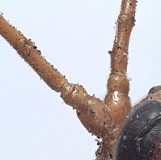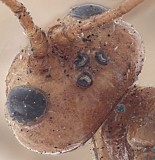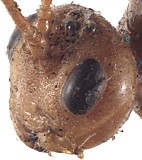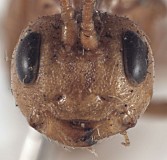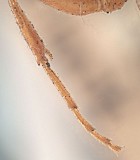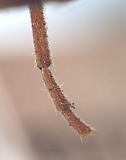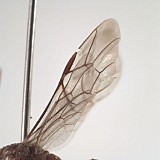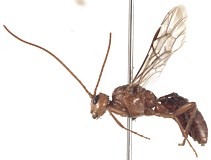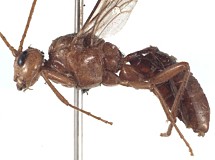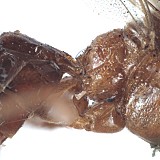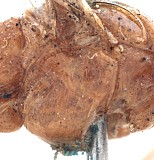Westwoodia rodmani Wharton and Roeder, 2008
Westwoodiini
Ctenopelmatinae
The low, somewhat irregular, parallel ridges on the frons may be remnants of the interantennal flanges seen in species such as W. romani and W. longipes, but these are not easy to discern amongst the generally rugose sculpture of the frons, and appear situated slightly differently than the diverging carinae of these other species. The inner hind tibial spur is longer in this species than in the others treated here.
This species, having several unique characteristics and known only from the male, is named in honor of Jim Rodman for his contributions to systematic biology.
Readily distinguished from other species of Westwoodia by the rugose face and entirely orange body (including antenna). In all other known species, there are at least some black markings on either the mesosoma, metasoma, or both. None of the other species have rugose facial sculpture. Facial sculpture is a useful identification feature for species of Westwoodia: finely and sparsely punctate, nearly smooth, in some species; densely punctate in others.
Westwoodia rodmani does not appear to be closely related to the other described species because of the more heavily sculptured body and unique coloration. It is the only species with hyaline wings. As in W. romani, n. sp., and W. longipes, however, there is no interantennal flange and the frons is at most shallowly impressed.
Known only from the southwestern corner of Western Australia.
There are no specimens currently determined for this OTU, or those specimens determined for this OTU are not yet mappable.
four labels
top label = printed, black ink on white paper, 4 lines as follows:
DENMARK
WESTERN AUSTRALIA
19 JAN 1984
R. P. MCMILLAN
2nd label = printed, black ink on white paper:
AT LIGHT (MV)
AT NIGHT
3rd label = black print on yellow paper:
Western Australian
Museum Entomology
Reg no 26618;
4th label = hand-written with black ink on white paper:
Westwoodia
det. MW SHORT 2000.
Paratype ♂ (Queensland Museum)
Two labels
top label = printed, black ink on white paper, 3 lines as follows:
Mundaring
W. Australia
J. Clark
2nd label = black ink on white paper, 2 lines (first hand-written, 2nd printed) as follows:
Westwoodia
det. I. D. Gauld, 1984
This material is based upon work supported by the National Science Foundation under Grant Number DEB 0328922 with REU supplement 0616851.
Any opinions, findings, and conclusions or recommendations expressed in this material are those of the author(s) and do not necessarily reflect the views of the National Science Foundation.

